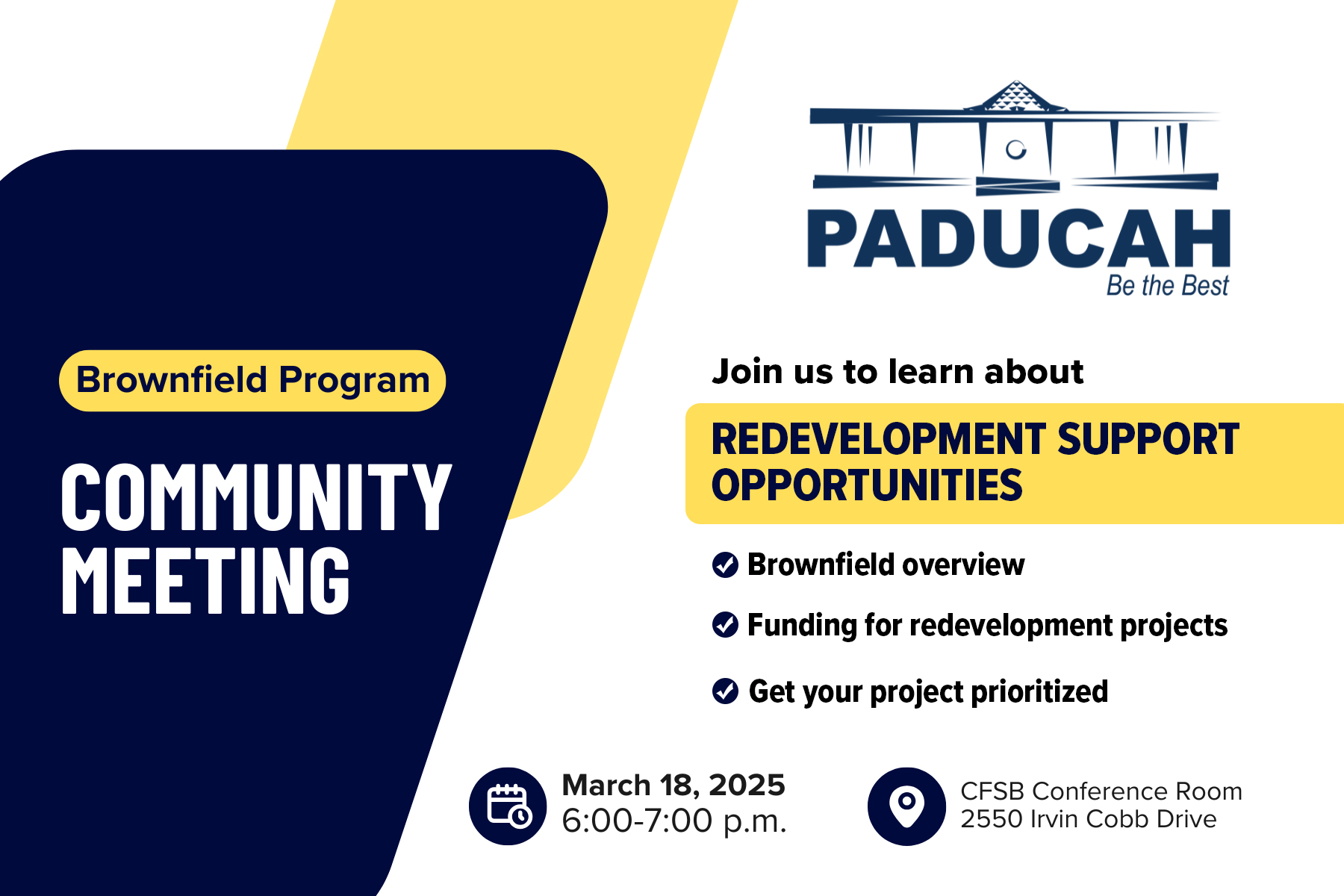City of Paducah Brownfields Program
Program Overview
Like all communities, Paducah has properties that are abandoned, underutilized, or blighted. These properties can be referred to as Brownfields and can be located anywhere. Examples of a possible brownfield property include
- a former gas station;
- a former dry-cleaning facility;
- an abandoned warehouse;
- a vacant city lot where a factory burned down years ago.
The City of Paducah's Brownfields Program works to assess, clean up, and facilitate the redevelopment / reuse of potentially contaminated properties known as brownfields within the city of Paducah. The program works in cooperation with Region 4 of the United States Environmental Protection Agency (EPA) and the State of Kentucky Department of Natural Resources. The program provides incentives and technical assistance for qualifying properties, including free Phase I and Phase II environmental assessments, cleanup planning, technical assistance, and low-to-no interest loans and sub-grants for site remediation.
City of Paducah – US EPA Brownfield Assessment Grant
The City of Paducah won a $500,000 EPA Assessment Grant in May 2022. The goal of this grant funding is to implement strategies to assess, plan for, and implement remedial strategies for brownfields in the Paducah-McCracken County area. A brownfield is a piece of property that is underutilized due to a perceived or real environmental impact.
Brownfields Frequently Asked Questions Presentation from March 2023 Kickoff Meeting
Targeted Areas in Paducah
Paducah has targeted three contiguous areas within the City to focus the EPA grant funding. The Riverfront, Gateway, and Southside Corridors represent approximately 20% of the City’s population, covering a land area of roughly four (4) square miles. It was determined that the greatest potential for brownfield reuse/redevelopment, which is consistent with the City’s existing Redevelopment Plans, is within these three areas.
Brownfields Program Application Criteria for Use of Assessment Funds Sample Property Access Agreement
Contact Information
If you have a question or need information, send an email to brownfieldspaducahky.gov.
 Paducah Brownfields Neighborhood Meeting - March 18, 2025
Paducah Brownfields Neighborhood Meeting - March 18, 2025
The City of Paducah is holding a Brownfield Program Neighborhood Meeting on Tuesday, March 18 from 6 until 7 p.m. at the Community Financial Services Bank (CFSB) conference room located at 2550 Irvin Cobb Drive.
In May 2022, the City of Paducah received a $500,000 EPA Assessment Grant with the funding goal of implementing strategies to assess, remediate, and forward the development of properties that are underutilized due to a perceived or real environmental impact.
At this meeting, Projects and Grants Coordinator Hope Reasons will provide an overview of the program, how it can benefit Southside neighborhoods, and existing projects especially in the Jefferson Street, Fountain Avenue, and Frenchtown neighborhoods.
Brownfields Basics
Brownfield Definition Brownfields are properties that are abandoned or underutilized due to real or perceived contamination. Examples of brownfields include old service stations, former dry cleaners, abandoned hospitals, and closed factories. Redeveloping these properties offer great benefits. However, the process is often hindered by the possibility of environmental concerns. These concerns are addressed through site assessments. Depending on the specific site characteristics, the assessment also can be used to protect a property owner or prospective purchaser from assuming liability for contamination they did not cause.
Assessment Process Environmental Site Assessments (ESAs) are typically conducted by environmental consultants trained and experienced in the areas of environmental investigation. A Phase I ESA is essentially an environmental Book Report for a specific property. It helps determine the potential for historical site impacts based on current and historical uses of the property. A Phase I ESA includes an inspection of the property, a review of historic records, and interviews with persons who may be familiar with the property. After completing assessment activities, the findings are presented in a final report. If the findings include the likelihood for site impact, then a Phase II ESA may be recommended. Potential impacts can include hazardous substances and petroleum products, as well as asbestos, lead-based paints, mold, and radon. While sampling is not part of a Phase I ESA, a Phase II ESA, if warranted, involves collecting and analyzing environmental samples to determine if impacts are present.
Assessment Advantages When owners allow their properties to be assessed for potential environmental concerns, they may come to realize that their property is more marketable than originally thought. At the very least, properties that have had an environmental site assessment are at an advantage for resale because they have already completed the necessary environmental due diligence that most lenders require for property transactions.
Liability Protection Fear of being held liable for pre-existing impacts is one of the biggest challenges to redeveloping brownfields. To help overcome this challenge, the state provides for liability protections under KRS 224.1-415. The Liability Relief Program, referred to as the 415 Program, protects prospective purchasers from being held responsible for historical site impacts. This significant liability protection is also available for future prospective purchasers as well.
